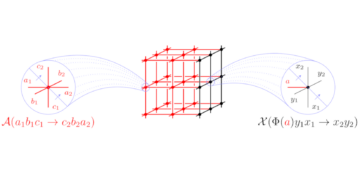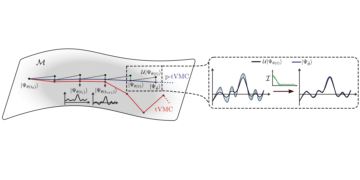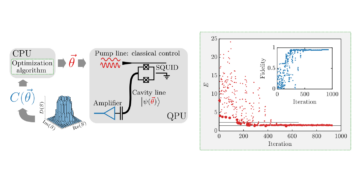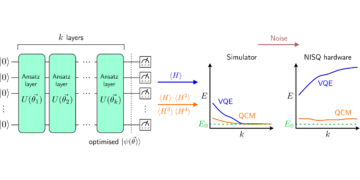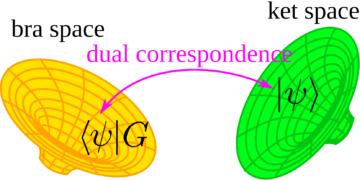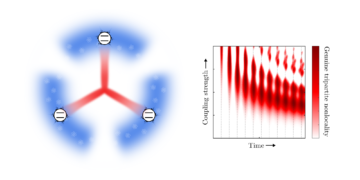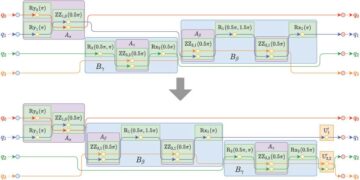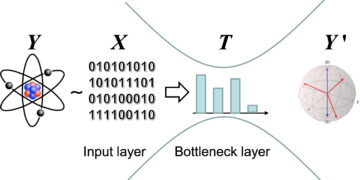1International Centre for Theory of Quantum Technologies, University of Gdańsk, 80-308 Gdańsk, Poland
2Perimeter Institute for Theoretical Physics, 31 Caroline Street North, Waterloo, Ontario Canada N2L 2Y5
3Institute for Quantum Computing and Department of Physics and Astronomy, University of Waterloo, Waterloo, Ontario N2L 3G1, Canada
4Department of Mathematics, University of York, Heslington, York YO10 5DD, United Kingdom
Find this paper interesting or want to discuss? Scite or leave a comment on SciRate.
Abstract
It is useful to have a criterion for when the predictions of an operational theory should be considered classically explainable. Here we take the criterion to be that the theory admits of a generalized-noncontextual ontological model. Existing works on generalized noncontextuality have focused on experimental scenarios having a simple structure: typically, prepare-measure scenarios. Here, we formally extend the framework of ontological models as well as the principle of generalized noncontextuality to arbitrary compositional scenarios. We leverage a process-theoretic framework to prove that, under some reasonable assumptions, every generalized-noncontextual ontological model of a tomographically local operational theory has a surprisingly rigid and simple mathematical structure — in short, it corresponds to a frame representation which is not overcomplete. One consequence of this theorem is that the largest number of ontic states possible in any such model is given by the dimension of the associated generalized probabilistic theory. This constraint is useful for generating noncontextuality no-go theorems as well as techniques for experimentally certifying contextuality. Along the way, we extend known results concerning the equivalence of different notions of classicality from prepare-measure scenarios to arbitrary compositional scenarios. Specifically, we prove a correspondence between the following three notions of classical explainability of an operational theory: (i) existence of a noncontextual ontological model for it, (ii) existence of a positive quasiprobability representation for the generalized probabilistic theory it defines, and (iii) existence of an ontological model for the generalized probabilistic theory it defines.

Featured image: In this work, we formally extend the definition of ontological models as well as the principle of generalized noncontextuality to arbitrary compositional scenarios. An ontological model of a generalized probabilistic theory (GPT) is a linear and diagram-preserving map taking GPT systems to classical random variables and taking GPT processes to stochastic matrices, such that the GPT probabilities are reproduced by the composition of the stochastic maps. Such a model corresponds to a noncontextual ontological model for the unquotiented operational theory that gave rise to the GPT.
► BibTeX data
► References
[1] R. W. Spekkens, Phys. Rev. A 71, 052108 (2005).
https://doi.org/10.1103/PhysRevA.71.052108
[2] R. W. Spekkens, Phys. Rev. Lett. 101, 020401 (2008).
https://doi.org/10.1103/PhysRevLett.101.020401
[3] C. Ferrie and J. Emerson, J. Phys. A: Math. Theor. 41, 352001 (2008).
https://doi.org/10.1088/1751-8113/41/35/352001
[4] D. Schmid, J. H. Selby, E. Wolfe, R. Kunjwal, and R. W. Spekkens, PRX Quantum 2, 010331 (2021a).
https://doi.org/10.1103/PRXQuantum.2.010331
[5] F. Shahandeh, PRX Quantum 2, 010330 (2021).
https://doi.org/10.1103/PRXQuantum.2.010330
[6] J. H. Selby, D. Schmid, E. Wolfe, A. B. Sainz, R. Kunjwal, and R. W. Spekkens, Phys. Rev. Lett. 130, 230201 (2023a).
https://doi.org/10.1103/PhysRevLett.130.230201
[7] J. H. Selby, D. Schmid, E. Wolfe, A. B. Sainz, R. Kunjwal, and R. W. Spekkens, Phys. Rev. A 107, 062203 (2023b).
https://doi.org/10.1103/PhysRevA.107.062203
[8] J. S. Bell, Physics 1, 195 (1964).
https://doi.org/10.1103/PhysicsPhysiqueFizika.1.195
[9] N. Brunner, D. Cavalcanti, S. Pironio, V. Scarani, and S. Wehner, Rev. Mod. Phys. 86, 419 (2014).
https://doi.org/10.1103/RevModPhys.86.419
[10] R. W. Spekkens, arXiv:1909.04628 [physics.hist-ph] (2019).
arXiv:1909.04628
[11] M. D. Mazurek, M. F. Pusey, R. Kunjwal, K. J. Resch, and R. W. Spekkens, Nat. Commun. 7, 11780 (2016).
https://doi.org/10.1038/ncomms11780
[12] R. W. Spekkens, D. H. Buzacott, A. J. Keehn, B. Toner, and G. J. Pryde, Phys. Rev. Lett. 102, 010401 (2009).
https://doi.org/10.1103/PhysRevLett.102.010401
[13] A. Chailloux, I. Kerenidis, S. Kundu, and J. Sikora, New J. Phys. 18, 045003 (2016).
https://doi.org/10.1088/1367-2630/18/4/045003
[14] A. Ambainis, M. Banik, A. Chaturvedi, D. Kravchenko, and A. Rai, Quant. Inf. Process. 18, 111 (2019).
https://doi.org/10.1007/s11128-019-2228-3
[15] D. Saha, P. Horodecki, and M. Pawłowski, New J. Phys. 21, 093057 (2019).
https://doi.org/10.1088/1367-2630/ab4149
[16] D. Saha and A. Chaturvedi, Phys. Rev. A 100, 022108 (2019).
https://doi.org/10.1103/PhysRevA.100.022108
[17] D. Schmid and R. W. Spekkens, Phys. Rev. X 8, 011015 (2018).
https://doi.org/10.1103/PhysRevX.8.011015
[18] M. Lostaglio and G. Senno, Quantum 4, 258 (2020).
https://doi.org/10.22331/q-2020-04-27-258
[19] D. Schmid, H. Du, J. H. Selby, and M. F. Pusey, arXiv:2101.06263 (2021b).
https://doi.org/10.1103/PhysRevLett.129.120403
arXiv:2101.06263
[20] P. Lillystone, J. J. Wallman, and J. Emerson, Phys. Rev. Lett. 122, 140405 (2019).
https://doi.org/10.1103/PhysRevLett.122.140405
[21] M. S. Leifer and R. W. Spekkens, Phys. Rev. Lett. 95, 200405 (2005), arXiv:quant-ph/0412178.
https://doi.org/10.1103/PhysRevLett.95.200405
arXiv:quant-ph/0412178
[22] M. F. Pusey and M. S. Leifer, in Proceedings of the 12th International Workshop on Quantum Physics and Logic, Electron. Proc. Theor. Comput. Sci., Vol. 195 (2015) pp. 295–306.
https://doi.org/10.4204/EPTCS.195.22
[23] M. F. Pusey, Phys. Rev. Lett. 113, 200401 (2014).
https://doi.org/10.1103/PhysRevLett.113.200401
[24] R. Kunjwal, M. Lostaglio, and M. F. Pusey, Phys. Rev. A 100, 042116 (2019).
https://doi.org/10.1103/PhysRevA.100.042116
[25] B. Coecke and A. Kissinger, in Categories for the Working Philosopher, edited by E. Landry (Oxford University Press, 2017) pp. 286–328.
https://doi.org/10.1093/oso/9780198748991.003.0012
[26] B. Coecke and A. Kissinger, Picturing Quantum Processes: A First Course in Quantum Theory and Diagrammatic Reasoning (Cambridge University Press, 2017).
https://doi.org/10.1017/9781316219317
[27] J. H. Selby, C. M. Scandolo, and B. Coecke, Quantum 5, 445 (2021).
https://doi.org/10.22331/q-2021-04-28-445
[28] S. Gogioso and C. M. Scandolo, in Proceedings of the 14th International Workshop on Quantum Physics and Logic, Electron. Proc. Theor. Comput. Sci., Vol. 266 (2018) pp. 367–385.
https://doi.org/10.4204/EPTCS.266.23
[29] L. Hardy, arXiv:quant-ph/0101012 (2001).
arXiv:quant-ph/0101012
[30] J. Barrett, Phys. Rev. A 75, 032304 (2007).
https://doi.org/10.1103/PhysRevA.75.032304
[31] L. Hardy, arXiv:1104.2066 [quant-ph] (2011).
arXiv:1104.2066
[32] G. Chiribella, G. M. D’Ariano, and P. Perinotti, Phys. Rev. A 81, 062348 (2010).
https://doi.org/10.1103/PhysRevA.81.062348
[33] G. Chiribella, G. M. D’Ariano, and P. Perinotti, Physical Review A 84, 012311 (2011).
https://doi.org/10.1103/PhysRevA.84.012311
[34] G. Chiribella, G. M. DAriano, and P. Perinotti, in Quantum theory: informational foundations and foils (Springer, 2016) pp. 171–221.
https://doi.org/10.48550/arXiv.1506.00398
[35] D. Schmid, J. H. Selby, and R. W. Spekkens, arXiv:2009.03297 (2020).
arXiv:2009.03297
[36] A. Gheorghiu and C. Heunen, in Proceedings of the 16th International Workshop on Quantum Physics and Logic, Electron. Proc. Theor. Comput. Sci., Vol. 318 (2020) pp. 196–212.
https://doi.org/10.4204/EPTCS.318.12
[37] J. van de Wetering, in Proceedings of the 14th International Workshop on Quantum Physics and Logic, Electron. Proc. Theor. Comput. Sci., Vol. 266 (2018) pp. 179–196.
https://doi.org/10.4204/EPTCS.266.12
[38] C. Ferrie and J. Emerson, New J. Phys. 11, 063040 (2009).
https://doi.org/10.1088/1367-2630/11/6/063040
[39] L. Hardy, Stud. Hist. Phil. Mod. Phys. 35, 267 (2004).
https://doi.org/10.1016/j.shpsb.2003.12.001
[40] P.-A. Mellies, in International Workshop on Computer Science Logic (Springer, 2006) pp. 1–30.
https://doi.org/10.1007/11874683_1
[41] G. Chiribella, G. M. D’Ariano, and P. Perinotti, Physical review letters 101, 060401 (2008a).
https://doi.org/10.1103/PhysRevLett.101.060401
[42] G. Chiribella, G. M. D’Ariano, and P. Perinotti, EPL (Europhysics Letters) 83, 30004 (2008b).
https://doi.org/10.1209/0295-5075/83/30004
[43] M. Wilson and G. Chiribella, in rm Proceedings 18th International Conference on Quantum Physics and Logic, rm Gdansk, Poland, and online, 7-11 June 2021, Electronic Proceedings in Theoretical Computer Science, Vol. 343, edited by C. Heunen and M. Backens (Open Publishing Association, 2021) pp. 265–300.
https://doi.org/10.4204/EPTCS.343.12
[44] T. Fritz and P. Perrone, in Proceedings of the Thirty-Fourth Conference on the Mathematical Foundations of Programming Semantics (MFPS XXXIV), Electron. Notes Theor. Comput. Sci., Vol. 341 (2018) pp. 121 – 149.
https://doi.org/10.1016/j.entcs.2018.11.007
[45] S. Mac Lane, Categories for the working mathematician, Vol. 5 (Springer Science & Business Media, 2013).
[46] G. Chiribella, in Proceedings of the 11th workshop on Quantum Physics and Logic, Electron. Notes Theor. Comput. Sci., Vol. 172 (2014) pp. 1 – 14.
https://doi.org/10.4204/EPTCS.172.1
[47] M. A. Nielsen and I. L. Chuang, Quantum Computation and Quantum Information (Cambridge University Press, 2010).
https://doi.org/10.1017/CBO9780511976667
[48] D. Schmid, K. Ried, and R. W. Spekkens, Phys. Rev. A 100, 022112 (2019).
https://doi.org/10.1103/PhysRevA.100.022112
[49] M. Appleby, C. A. Fuchs, B. C. Stacey, and H. Zhu, Eur. Phys. J. D 71, 197 (2017).
https://doi.org/10.1140/epjd/e2017-80024-y
[50] R. W. Spekkens, Phys. Rev. A 75, 032110 (2007).
https://doi.org/10.1103/PhysRevA.75.032110
[51] D. Gottesman, in 22nd International Colloquium on Group Theoretical Methods in Physics (1999) pp. 32–43, arXiv:quant-ph/9807006.
arXiv:quant-ph/9807006
[52] L. Hardy and W. K. Wootters, Found. Phys. 42, 454 (2012).
https://doi.org/10.1007/s10701-011-9616-6
[53] N. Harrigan, T. Rudolph, and S. Aaronson, arXiv:0709.1149 (2007).
arXiv:0709.1149
[54] R. W. Spekkens, Noncontextuality: how we should define it, why it is natural, and what to do about its failure (2017), PIRSA:17070035.
http://pirsa.org/17070035
[55] E. G. Beltrametti and S. Bugajski, J. Phys. A 28, 3329 (1995).
https://doi.org/10.1088/0305-4470/28/12/007
[56] J. J. Wallman and S. D. Bartlett, Phys. Rev. A 85, 062121 (2012).
https://doi.org/10.1103/PhysRevA.85.062121
[57] F. Riesz, in Annales scientifiques de l’École Normale Supérieure, Vol. 31 (1914) pp. 9–14.
[58] V. Gitton and M. P. Woods, Quantum 6, 732 (2022).
https://doi.org/10.22331/q-2022-06-07-732
[59] A. Karanjai, J. J. Wallman, and S. D. Bartlett, arXiv:1802.07744 (2018).
arXiv:1802.07744
[60] R. W. Spekkens, in Quantum Theory: Informational Foundations and Foils, edited by G. Chiribella and R. W. Spekkens (Springer Netherlands, Dordrecht, 2016) pp. 83–135.
https://doi.org/10.1007/978-94-017-7303-4_4
[61] R. W. Spekkens, The paradigm of kinematics and dynamics must yield to causal structure, in Questioning the Foundations of Physics: Which of Our Fundamental Assumptions Are Wrong?, edited by A. Aguirre, B. Foster, and Z. Merali (Springer International Publishing, Cham, 2015) pp. 5–16.
https://doi.org/10.1007/978-3-319-13045-3_2
[62] N. Harrigan and R. W. Spekkens, Found. Phys. 40, 125 (2010).
https://doi.org/10.1007/s10701-009-9347-0
[63] R. W. Spekkens, Found. Phys. 44, 1125 (2014).
https://doi.org/10.1007/s10701-014-9833-x
[64] M. F. Pusey, J. Barrett, and T. Rudolph, Nat. Phys. 8, 475 (2012).
https://doi.org/10.1038/nphys2309
[65] K. Husimi, Proc. Physico-Mathematical Soc. Jpn. 3rd Series 22, 264 (1940).
https://doi.org/10.11429/ppmsj1919.22.4_264
[66] R. J. Glauber, Phys. Rev. 131, 2766 (1963).
https://doi.org/10.1103/PhysRev.131.2766
[67] E. C. G. Sudarshan, Phys. Rev. Lett. 10, 277 (1963).
https://doi.org/10.1103/PhysRevLett.10.277
[68] K. S. Gibbons, M. J. Hoffman, and W. K. Wootters, Phys. Rev. A 70, 062101 (2004).
https://doi.org/10.1103/PhysRevA.70.062101
[69] D. Gross, J. Math. Phys. 47, 122107 (2006).
https://doi.org/10.1063/1.2393152
[70] A. Krishna, R. W. Spekkens, and E. Wolfe, New J, Phys. 19, 123031 (2017).
https://doi.org/10.1088/1367-2630/aa9168
[71] D. Schmid, R. W. Spekkens, and E. Wolfe, Phys. Rev. A 97, 062103 (2018).
https://doi.org/10.1103/PhysRevA.97.062103
[72] M. Howard, J. Wallman, V. Veitch, and J. Emerson, Nature 510, 351 (2014).
https://doi.org/10.1038/nature13460
[73] M. D. Mazurek, M. F. Pusey, K. J. Resch, and R. W. Spekkens, PRX Quantum 2, 020302 (2021).
https://doi.org/10.1103/PRXQuantum.2.020302
Cited by
[1] Costantino Budroni, Adán Cabello, Otfried Gühne, Matthias Kleinmann, and Jan-Åke Larsson, “Kochen-Specker contextuality”, Reviews of Modern Physics 94 4, 045007 (2022).
[2] Martin Plávala, “General probabilistic theories: An introduction”, Physics Reports 1033, 1 (2023).
[3] John H. Selby, Carlo Maria Scandolo, and Bob Coecke, “Reconstructing quantum theory from diagrammatic postulates”, arXiv:1802.00367, (2018).
[4] Thomas D. Galley, Flaminia Giacomini, and John H. Selby, “A no-go theorem on the nature of the gravitational field beyond quantum theory”, Quantum 6, 779 (2022).
[5] David Schmid, Haoxing Du, John H. Selby, and Matthew F. Pusey, “Uniqueness of Noncontextual Models for Stabilizer Subtheories”, Physical Review Letters 129 12, 120403 (2022).
[6] Lorenzo Catani, Matthew Leifer, David Schmid, and Robert W. Spekkens, “Why interference phenomena do not capture the essence of quantum theory”, Quantum 7, 1119 (2023).
[7] Vinicius P. Rossi, David Schmid, John H. Selby, and Ana Belén Sainz, “Contextuality with vanishing coherence and maximal robustness to dephasing”, Physical Review A 108 3, 032213 (2023).
[8] John H. Selby, David Schmid, Elie Wolfe, Ana Belén Sainz, Ravi Kunjwal, and Robert W. Spekkens, “Contextuality without Incompatibility”, Physical Review Letters 130 23, 230201 (2023).
[9] John H. Selby, Elie Wolfe, David Schmid, Ana Belén Sainz, and Vinicius P. Rossi, “Linear Program for Testing Nonclassicality and an Open-Source Implementation”, Physical Review Letters 132 5, 050202 (2024).
[10] Kieran Flatt, Hanwool Lee, Carles Roch I. Carceller, Jonatan Bohr Brask, and Joonwoo Bae, “Contextual Advantages and Certification for Maximum-Confidence Discrimination”, PRX Quantum 3 3, 030337 (2022).
[11] Lorenzo Catani, Matthew Leifer, Giovanni Scala, David Schmid, and Robert W. Spekkens, “Aspects of the phenomenology of interference that are genuinely nonclassical”, Physical Review A 108 2, 022207 (2023).
[12] John H. Selby, David Schmid, Elie Wolfe, Ana Belén Sainz, Ravi Kunjwal, and Robert W. Spekkens, “Accessible fragments of generalized probabilistic theories, cone equivalence, and applications to witnessing nonclassicality”, Physical Review A 107 6, 062203 (2023).
[13] Laurens Walleghem, Shashaank Khanna, and Rutvij Bhavsar, “Comment on a no-go theorem for $psi$-ontic models”, arXiv:2402.13140, (2024).
[14] Roberto D. Baldijão, Rafael Wagner, Cristhiano Duarte, Bárbara Amaral, and Marcelo Terra Cunha, “Emergence of Noncontextuality under Quantum Darwinism”, PRX Quantum 2 3, 030351 (2021).
[15] Nikolaos Koukoulekidis and David Jennings, “Constraints on magic state protocols from the statistical mechanics of Wigner negativity”, npj Quantum Information 8, 42 (2022).
[16] Stefano Gogioso and Nicola Pinzani, “The Topology of Causality”, arXiv:2303.07148, (2023).
[17] Rafael Wagner, Anita Camillini, and Ernesto F. Galvão, “Coherence and contextuality in a Mach-Zehnder interferometer”, Quantum 8, 1240 (2024).
[18] David Schmid, John H. Selby, and Robert W. Spekkens, “Addressing some common objections to generalized noncontextuality”, Physical Review A 109 2, 022228 (2024).
[19] John H. Selby, Carlo Maria Scandolo, and Bob Coecke, “Reconstructing quantum theory from diagrammatic postulates”, Quantum 5, 445 (2021).
[20] Anubhav Chaturvedi, Máté Farkas, and Victoria J. Wright, “Characterising and bounding the set of quantum behaviours in contextuality scenarios”, Quantum 5, 484 (2021).
[21] Jamie Sikora and John H. Selby, “Impossibility of coin flipping in generalized probabilistic theories via discretizations of semi-infinite programs”, Physical Review Research 2 4, 043128 (2020).
[22] Rafael Wagner, Rui Soares Barbosa, and Ernesto F. Galvão, “Inequalities witnessing coherence, nonlocality, and contextuality”, arXiv:2209.02670, (2022).
[23] Giacomo Mauro D’Ariano, Marco Erba, and Paolo Perinotti, “Classicality without local discriminability: Decoupling entanglement and complementarity”, Physical Review A 102 5, 052216 (2020).
[24] Rafael Wagner, Roberto D. Baldijão, Alisson Tezzin, and Bárbara Amaral, “Using a resource theoretic perspective to witness and engineer quantum generalized contextuality for prepare-and-measure scenarios”, Journal of Physics A Mathematical General 56 50, 505303 (2023).
[25] David Schmid, “A review and reformulation of macroscopic realism: resolving its deficiencies using the framework of generalized probabilistic theories”, Quantum 8, 1217 (2024).
[26] Giulio Chiribella, Lorenzo Giannelli, and Carlo Maria Scandolo, “Bell nonlocality in classical systems”, arXiv:2301.10885, (2023).
[27] Victor Gitton and Mischa P. Woods, “Solvable Criterion for the Contextuality of any Prepare-and-Measure Scenario”, arXiv:2003.06426, (2020).
[28] Marco Erba, Paolo Perinotti, Davide Rolino, and Alessandro Tosini, “Measurement incompatibility is strictly stronger than disturbance”, Physical Review A 109 2, 022239 (2024).
[29] Robert Raussendorf, Cihan Okay, Michael Zurel, and Polina Feldmann, “The role of cohomology in quantum computation with magic states”, arXiv:2110.11631, (2021).
[30] Martin Plávala, “Incompatibility in restricted operational theories: connecting contextuality and steering”, Journal of Physics A Mathematical General 55 17, 174001 (2022).
[31] Sidiney B. Montanhano, “Differential Geometry of Contextuality”, arXiv:2202.08719, (2022).
[32] Victor Gitton and Mischa P. Woods, “Solvable Criterion for the Contextuality of any Prepare-and-Measure Scenario”, Quantum 6, 732 (2022).
[33] John H. Selby, Ana Belén Sainz, Victor Magron, Łukasz Czekaj, and Michał Horodecki, “Correlations constrained by composite measurements”, Quantum 7, 1080 (2023).
[34] Paulo J. Cavalcanti, John H. Selby, Jamie Sikora, and Ana Belén Sainz, “Decomposing all multipartite non-signalling channels via quasiprobabilistic mixtures of local channels in generalised probabilistic theories”, Journal of Physics A Mathematical General 55 40, 404001 (2022).
[35] Leevi Leppäjärvi, “Measurement simulability and incompatibility in quantum theory and other operational theories”, arXiv:2106.03588, (2021).
[36] Lorenzo Catani, “Relationship between covariance of Wigner functions and transformation noncontextuality”, arXiv:2004.06318, (2020).
[37] Russell P Rundle and Mark J Everitt, “Overview of the phase space formulation of quantum mechanics with application to quantum technologies”, arXiv:2102.11095, (2021).
[38] Robert Raussendorf, Cihan Okay, Michael Zurel, and Polina Feldmann, “The role of cohomology in quantum computation with magic states”, Quantum 7, 979 (2023).
The above citations are from SAO/NASA ADS (last updated successfully 2024-03-15 13:00:22). The list may be incomplete as not all publishers provide suitable and complete citation data.
On Crossref’s cited-by service no data on citing works was found (last attempt 2024-03-15 13:00:19).
This Paper is published in Quantum under the Creative Commons Attribution 4.0 International (CC BY 4.0) license. Copyright remains with the original copyright holders such as the authors or their institutions.
- SEO Powered Content & PR Distribution. Get Amplified Today.
- PlatoData.Network Vertical Generative Ai. Empower Yourself. Access Here.
- PlatoAiStream. Web3 Intelligence. Knowledge Amplified. Access Here.
- PlatoESG. Carbon, CleanTech, Energy, Environment, Solar, Waste Management. Access Here.
- PlatoHealth. Biotech and Clinical Trials Intelligence. Access Here.
- Source: https://quantum-journal.org/papers/q-2024-03-14-1283/
- :has
- :is
- :not
- ][p
- 00
- 001
- 003
- 09
- 1
- 10
- 100
- 101
- 102
- 107
- 11
- 11th
- 12
- 121
- 125
- 12th
- 13
- 130
- 14
- 14th
- 15%
- 16
- 16th
- 17
- 18th
- 19
- 195
- 1995
- 1999
- 2%
- 20
- 2001
- 2005
- 2006
- 2007
- 2008
- 2009
- 2010
- 2011
- 2012
- 2013
- 2014
- 2015
- 2016
- 2017
- 2018
- 2019
- 2020
- 2021
- 2022
- 2023
- 2024
- 21
- 22
- 23
- 24
- 25
- 26
- 264
- 27
- 28
- 29
- 30
- 31
- 32
- 33
- 34
- 35%
- 36
- 39
- 3rd
- 4
- 40
- 41
- 42
- 45
- 46
- 48
- 49
- 5
- 50
- 51
- 52
- 54
- 55
- 58
- 6
- 60
- 62
- 65
- 66
- 67
- 7
- 70
- 72
- 73
- 75
- 8
- 84
- 9
- 97
- a
- About
- above
- ABSTRACT
- access
- accessible
- addressing
- admits
- advantages
- affiliations
- All
- along
- an
- Ana
- and
- any
- Application
- applications
- arbitrary
- ARE
- AS
- aspects
- associated
- Association
- assumptions
- astronomy
- attempt
- author
- authors
- b
- BE
- behaviours
- Bell
- between
- Beyond
- bob
- Break
- business
- by
- cambridge
- Canada
- capture
- caroline
- categories
- centre
- Certification
- channels
- citing
- Coin
- comment
- Common
- Commons
- complete
- composition
- computation
- computer
- computer science
- computing
- concerning
- Conference
- Connecting
- consequence
- considered
- constrained
- constraint
- constraints
- contextual
- copyright
- correlations
- corresponds
- course
- data
- David
- de
- decomposing
- deficiencies
- define
- Defines
- definition
- Den
- Department
- different
- Dimension
- Discrimination
- discuss
- do
- dynamics
- e
- edited
- Electronic
- emergence
- engineer
- entanglement
- equivalence
- essence
- Ether (ETH)
- EUR
- Every
- existence
- existing
- experimental
- Explainability
- extend
- Failure
- field
- First
- flipping
- focused
- following
- For
- Formally
- formulation
- Foster
- found
- Foundations
- FRAME
- Framework
- from
- functions
- fundamental
- gave
- General
- generalized
- generating
- genuinely
- geometry
- giovanni
- given
- gravitational
- gross
- Group
- harvard
- Have
- having
- here
- holders
- How
- howard
- http
- HTTPS
- i
- ii
- iii
- image
- implementation
- in
- inequalities
- information
- Informational
- Institute
- institutions
- interesting
- interference
- International
- Introduction
- IT
- ITS
- Jamie
- JavaScript
- jennings
- John
- joonwoo
- journal
- june
- known
- Lane
- largest
- Last
- Leave
- Lee
- Leverage
- License
- linear
- List
- local
- logic
- mac
- magic
- map
- Maps
- mar
- Marco
- maria
- mark
- Martin
- math
- mathematical
- mathematics
- matthew
- matthias
- mauro
- max-width
- May..
- measurement
- measurements
- mechanics
- Media
- methods
- Michael
- model
- models
- Modern
- Month
- must
- Natural
- Nature
- Netherlands
- New
- no
- North
- Notes
- notions
- number
- objections
- of
- Okay
- on
- ONE
- online
- Ontario
- open
- open source
- operational
- or
- original
- Other
- our
- overview
- Oxford
- oxford university
- pages
- Paolo
- Paper
- paradigm
- perspective
- phase
- PHIL
- physical
- Physics
- plato
- Plato Data Intelligence
- PlatoData
- Poland
- positive
- possible
- Predictions
- press
- principle
- probabilities
- PROC
- Proceedings
- process
- processes
- Program
- Programming
- Programs
- protocols
- Prove
- provide
- published
- publisher
- publishers
- Publishing
- Quant
- Quantum
- quantum computing
- quantum information
- Quantum Mechanics
- quantum physics
- R
- Rafael
- random
- realism
- reasonable
- reasoning
- references
- relationship
- remains
- Reports
- representation
- research
- resolving
- resource
- restricted
- Results
- review
- rigid
- Rise
- ROBERT
- roberto
- robustness
- Role
- s
- Scala
- scenario
- scenarios
- SCI
- Science
- semantics
- Series
- set
- Short
- should
- Simple
- some
- Space
- specifically
- State
- States
- statistical
- steering
- street
- strictly
- stronger
- structure
- Successfully
- such
- suitable
- surprisingly
- Systems
- T
- Take
- taking
- techniques
- Technologies
- Terra
- Testing
- than
- that
- The
- their
- theorem
- theoretical
- theory
- this
- thomas
- three
- Title
- to
- Transformation
- typically
- under
- uniqueness
- United
- university
- updated
- URL
- useful
- using
- van
- variables
- via
- Victoria
- volume
- W
- want
- was
- Way..
- we
- WELL
- What
- when
- which
- why
- Wilson
- with
- without
- witness
- witnessing
- Woods
- Work
- working
- works
- workshop
- Wright
- Wrong
- X
- year
- Yield
- york
- zephyrnet

